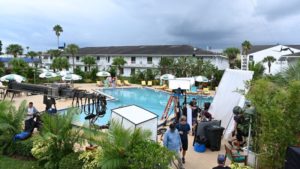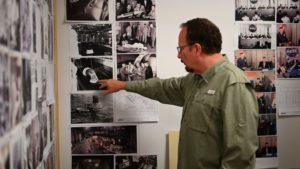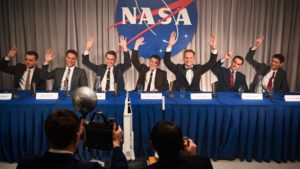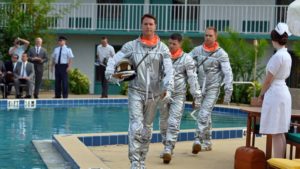
For Appian Way’s producer Jennifer Davisson, among the many properties offered to the company she and overall proprietor Leonardo DiCaprio were analyzing for production potential was pilot Chuck Yeager’s autobiography, with regards to adapting it into a feature film. While that project did not move forward into the development phase, another Appian Way executive suggested turning Tom Wolfe’s historical novel The Right Stuff into a series. Having already been adapted by director Philip Kaufman into the 1983 feature film, The Right Stuff, the series was approved by Wolfe and molded by Appian Way into a show that focused more on the lives of its principal characters.
With National Geographic on board and Warner Bros having a minority interest in the production, writer Will Staples devised a number of drafts of the pilot, followed by Mark Lafferty whose first pilot draft was green lit. “We thought we were going to be on Nat Geo,” said Davisson. “We found out four-five months ago that we’d be a premiere on Disney +. They have been these really incredible partners—the reach is unparalleled.”
Initially, Davisson and her team sought to find a director and location for the pilot. “It was very important for us to shoot in Florida,” Davisson explained. “We were in the actual locations where these things happened. How better to recreate that than actually be there?”
Critical to Appian Way establishing the series was bringing in The Right Stuff’s key crew members. “Derek Hill, our production designer, is so incredible,” said Davisson. “Hope Hanafin is a classy, unbelievably talented costume designer. Then, we started to move forward with casting.”
At the time of the launch of N.A.S.A.’s Mercury space program, in October of 1958, the original seven astronauts were largely unknown. “Which one of these seven guys was going to be the first in space?” Davisson noted as a key to the dramatic tension in The Right Stuff series. “To have a bunch of guys who weren’t that recognizable all put on equal footing. It’s hard to cast series regulars—we had 13, and each one of them was better than the next.”
When Derek Hill came aboard The Right Stuff, he wanted to work on a show of intense magnitude. “You are trying to recreate history,” he said. “Any time I can work a different genre—that I haven’t worked—I always look at it as a plus in my repertoire. Who wouldn’t want to work on The Right Stuff?”

As Hill signed on to the project, he knew that The Right Stuff was going to present major hurdles. “It’s a space movie, so it’s not going to be cheap,” he said, “I seem to get the harder, difficult shows. This is going to be a challenge all around. I arrived mid-May, 2019, and we started shooting the latter part of July.”
While working on another project in New Zealand, on his nights and weekends, Hill broke down the pilot teleplay. “We were going to cover from early 1954 when John Glenn almost crashed, to the beginning of the N.A.S.A. program in 1958, until Alan Shepard flies on May 5, 1961,” he explained of his design tasks ahead. “All of these dates became important milestones for us. The audience is really intelligent on the subject matter; I’m going to work harder—get as much information as I can. We are going to delve deep into the stories of the astronauts and how it affected their lives and their families.”
In his research, Hill knew that he needed to acquire a Mercury space capsule, first and foremost, and economize his sets in a small selection of sound stage space in Orlando. “I had to have a space capsule to pull the side off, and we’ll need three of them for all of the elements,” he stated of his first search. “I thought we needed to build the N.A.S.A. conference room and offices on one stage, and create some hallways and Mercury Control in Cape Canaveral on the same stage. I found an exterior building that worked great for the viewing stand where they went out at N.A.S.A. to watch the space launch; I mocked up the entrance to match that location. It was all on the same stage: wall-to-wall.”
On a separate stage, Hill crafted other key sets for The Right Stuff, in keeping with period and historical detail. “On the other stage was Hangar S where they trained and lived,” Hill described. “I started at the back of the stage and built forward: the dorm that they lived in, the medical facility, a hallway out, and I put a wall up two-thirds of the way through the stage. We were going to shoot exterior hangar shots at Cape Canaveral, but, then, we couldn’t afford to go to Cape Canaveral several times a week. I laid that stage out, and we needed a conference room where they introduce the N.A.S.A. astronauts in Washington, D.C., so I built it off a hallway. We needed the training center in Albuquerque, New Mexico, so I built those rooms off of the left side. I had most of it built out, and little wings and pockets to change sets over. We found an old airport/hangar where a collector owned a bunch of airplanes. We did the Albuquerque terminal there and the tarmac where they walk out of the hangar. It was a visual effect when they turned around. We ended up using every space possible.”
As a key part of his team, Hill brought in a conceptual illustrator. “I try to have one on every show,” Hill revealed. “I re-concepted everything, like the capsule in the water when they are doing the training. I did a dozen illustrations for that show. I find it easier when we are doing big stuff like that if there’s a question about what we are going to do or how we are going to achieve it. If we are touching it, we are going to build it. I find that most directors want as much practical as they possibly can. Some of it is, economically, not feasible. I would design stuff that would work for the visual effects department. On this show, it’s pretty seamless.”

Additionally, Hill built a triangulating training device 34-feet-tall called a Mastiff, utilized to test the astronauts’ equilibrium. “That was a very expensive build,” he said. “It was a struggle to get that done. We had to get it tested and certified for safety. We also shot at the actual Cape Canaveral launch pad. We got a fuselage of an F-84 [aircraft] and built the F-104 out of pieces and parts. We had an expensive gimbal that we mounted the airplanes on.”
In Hill’s art department, he had the services of two set designers, two art directors, and art department coordinator, plus several others, for nine total. He employed set decorators and other critical craftspeople with local talent in central Florida. “This is going to be one of those where I re-created history, and I got it right,” Hill professed. “That, to me, is a victory — what you created is as accurate as possible.”
When costume designer Hope Hanafin joined The Right Stuff, she did not have previous knowledge of the Mercury space program. “It seemed scary and remote,” she said of the daunting task of executing 9000 costumes for the series. “What did interest me was pouring through the Life Magazine articles. We built almost nothing—we used 44 different sources from all over the country. I was in deserted warehouses digging through boxes of clothing bins, up to my waist. The world is richer than my imagination.”
In order to set The Right Stuff firmly in the mid-to-late-1950s and early-1960s, Hanafin relied on her decades of experience of costume design on major film and television projects. “You help create the world and dress the background,” she stated. “One character can change clothes six, seven, eight times in an episode. One of the challenges is that we had to show passage of time and seasons—we would have to amend [costumes]—we did many alterations and repairs.”
With assistant costume designer Kristine N. Haag and costume supervisor Katie Saunders, just as Hill relied on local art department talent, Hanafin also called upon a large team of costume craftspeople in Florida. “We had five weeks, which is not enough,” said Hanafin of her preparatory period. “We knew that we were going in and only doing the pilot, then break for a couple of weeks, and go back and do the rest of the episodes. We didn’t have to get all of it ready at one time. I wanted to get the spacesuits in-progress early.”
Working with Global Effects in Los Angeles, Hanafin crafted the crucial look of the spacesuits. “They are museum quality down to the lacings,” she said. “We only built three—they are never all wearing them at the same time. They are very awkward, hot, and heavy.”

As the seven original astronauts had very similar ethnic makeups, Hanafin sought to introduce, then differentiate those characters to an audience used to seeing a more diverse cast. “One of the ways I hope we solved that is that the wives present very different appearances from each other,” Hanafin divulged, adding that she determined each astronaut’s wife’s personal style by clues found in their biographies. “Almost all of these characters, even those minor in the first episode, have written books. The actors had read the books—they came in with such enthusiasm and the wealth of knowledge. They had done the research, and we worked on that together.”
Of note, Hanafin was undaunted by the time period in which the series resided as she had not only designed costumes for the period many times before, but she also lived through it. “But it was different to do this version—the Sears Roebuck/Montgomery Ward version,” she said. “We can go back to the same period, but even it if was the same cultural and economic group, the story you’re telling may be different—looking at the period from a new lens. My hope was it would be a little bit of Dorothy opening the door to Oz. You sense the body underneath the clothes, instead of just the structure of the clothes. It’s not just the clothes, but how to wear the clothes.”
For her part in The Right Stuff, Hanafin wished that audiences could identify the actual individuals behind the true story. “These were people with real commitment who can work together and create something extraordinary that is appreciated and inspires other people,” she unveiled of her perspective. “To make the clothes accessible and real and not aspirational. Everyone comes together and says, ‘Oh, that is possible.’ It’s about real people committing to real things.”
Finally, Jennifer Davisson noted that she did not engage in The Right Stuff as a natural aficionado of the space program. “For me, what I was really compelled by was these really complicated characters,” she detailed. “What’s the psychological makeup of somebody who’s willing to risk our life for the greater good? I find them to be inspiring and heroic and really broken in an unbelievably complicated way. You show up for the space, but you stay for the characters.”





